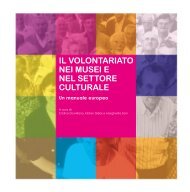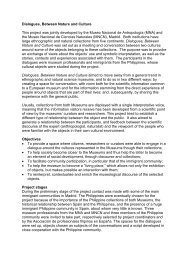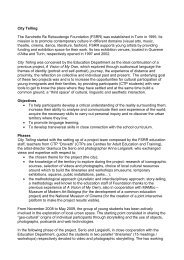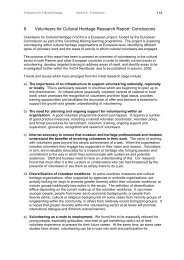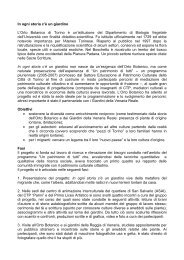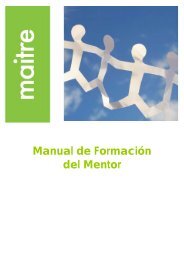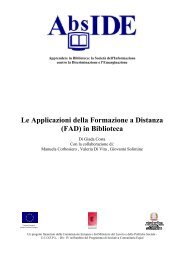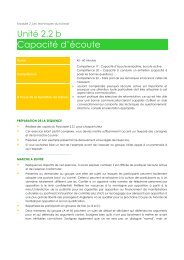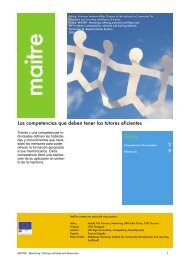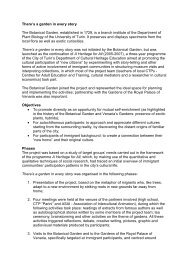Museums as places for intercultural dialogue - Network of European ...
Museums as places for intercultural dialogue - Network of European ...
Museums as places for intercultural dialogue - Network of European ...
Create successful ePaper yourself
Turn your PDF publications into a flip-book with our unique Google optimized e-Paper software.
InstitutionThe National Museum <strong>of</strong> Cinemahttp://www.museocinema.itProject CoordinatorsPaola Traversi, Head <strong>of</strong> Education - traversi@museocinema.it /Roberta Zendrini, Education Department - didattica2@museocinema.itTarget groupsThe project involved participants from different educational contexts (immigrantsattending local centres <strong>for</strong> adult education and training and students <strong>of</strong> technicalcolleges specialising in audiovisuals / multimedia), in order to collect, compareand share different points <strong>of</strong> view in a single product.Map <strong>for</strong> TurinThe National Museum <strong>of</strong> Cinema h<strong>as</strong> been located inside the MoleAntonelliana since 2000. François Confino’s spectacular settingh<strong>as</strong> turned this historic building representing the city <strong>of</strong> Turin into aunique vertical museum, which hosts a rich heritage covering thearchaeology <strong>of</strong> cinema, the history <strong>of</strong> photography, movie posters,cinema photographic records and stage sets. It is Turin’s mostvisited museum, with over 500,000 visitors every year. The EducationDepartment <strong>of</strong>fers a wide range <strong>of</strong> services <strong>for</strong> schools and adults,and more recently h<strong>as</strong> begun to address migrant communities throughad-hoc projects.Map <strong>for</strong> Turin involved participants (native and immigrant students fromlocal Centres <strong>for</strong> Adult Education and Training and secondary schools)in the production <strong>of</strong> four short films on the theme <strong>of</strong> <strong>intercultural</strong><strong>dialogue</strong>, b<strong>as</strong>ed on two key components: autobiographical storytellingand the <strong>intercultural</strong> interpretation <strong>of</strong> Museum collections.Objectives• To give voice to the participants’ life experiences, through theproduction <strong>of</strong> short films drawing inspiration from significant spots <strong>of</strong>the city and the Museum collections;• To use audiovisual workshops <strong>as</strong> a cohesive tool in cl<strong>as</strong>ses markedby strong cultural differences;• To develop participants’ knowledge <strong>of</strong> the cinema world and skills infilm-making, <strong>as</strong> well <strong>as</strong> linguistic skills;• To encourage the active and constant involvement <strong>of</strong> participantsthroughout the different ph<strong>as</strong>es <strong>of</strong> the project: planning,implementation, dissemination;• To make the National Museum <strong>of</strong> Cinema an accessible institution,open to the <strong>dialogue</strong> between cultures.Ph<strong>as</strong>es• Presentation <strong>of</strong> the project and <strong>of</strong> Museum collections to thecl<strong>as</strong>ses involved;• Selection <strong>of</strong> an object from the Museum collections, to bephotographed by project participants and subsequently used in thefilm script <strong>as</strong> an integral part <strong>of</strong> the story;• Group discussions around the themes <strong>of</strong> migration, integration,dynamic identities, <strong>intercultural</strong> conflicts, starting from the screening<strong>of</strong> purposely selected and edited film sequences;• Personal drafting <strong>of</strong> a short story;• Cooperative drafting <strong>of</strong> a script <strong>for</strong> a short film in each cl<strong>as</strong>s;• C<strong>as</strong>ting and shooting;• Editing.Teachers played a fundamental role in the planning and implementation<strong>of</strong> Map <strong>for</strong> Turin, which posed the challenge <strong>of</strong> addressing verydifferent learning contexts. Together with the Museum educationstaff, they defined the different ph<strong>as</strong>es <strong>of</strong> the project <strong>as</strong> well <strong>as</strong> theeducational methodologies to be employed in order to meet thespecific needs <strong>of</strong> each participant group.Results and learning pointsThe use <strong>of</strong> film sequences in an <strong>intercultural</strong> key w<strong>as</strong> a strength <strong>of</strong> theproject: their direct language triggered strong emotional responses,which in turn provided a valuable starting point <strong>for</strong> discussion on<strong>intercultural</strong> issues <strong>as</strong> well <strong>as</strong> <strong>for</strong> autobiographical storytelling.The audiovisual production process also turned out to be a usefuldevice <strong>for</strong> the active involvement <strong>of</strong> highly heterogeneous groups.Working with movie images helped to overcome linguistic barriers(which <strong>of</strong>ten account <strong>for</strong> the “exclusion” <strong>of</strong> migrant communitiesfrom mainstream educational <strong>of</strong>fer), elicit complex process <strong>of</strong> culturalre-negotiation, and tackle important and <strong>of</strong>ten controversial issues <strong>of</strong>contemporary society in a less conflicting manner.Quite interestingly, the most challenging stories from a creative point<strong>of</strong> view emerged from the most problematic contexts (due toorganisational re<strong>as</strong>ons or to conflicts and tensions inside the individualgroups).The four short films produced in the framework <strong>of</strong> the project –Gregorio’s cut, Il muccale (a play on two words untranslatable inEnglish), We are not alone and Guess who’s coming to dinner –represent a new valuable tool <strong>for</strong> the Museum to stimulate debateon <strong>intercultural</strong> issues. Starting from autumn 2009, they will be madeavailable both on a multimedia plat<strong>for</strong>m – designed by one <strong>of</strong> thesecondary schools which took part in the project (see also City Tellingpilot projects in Turin and Bologna) – and in DVD <strong>for</strong>mat, so <strong>as</strong> toensure <strong>as</strong> wide a circulation <strong>as</strong> possible in local schools, communitycentres and national and international conferences, in which projectparticipants will be actively involved.In parallel with the development <strong>of</strong> Map <strong>for</strong> Turin, the Museum startednew partnerships with other institutions/realities working in the <strong>intercultural</strong>field (ISMU Foundation – Initiatives and Studies on Multiethnicity, Milan;The Gate project, Turin), and more in general is committed to pursuingits <strong>intercultural</strong> engagement in the coming years.38 39



